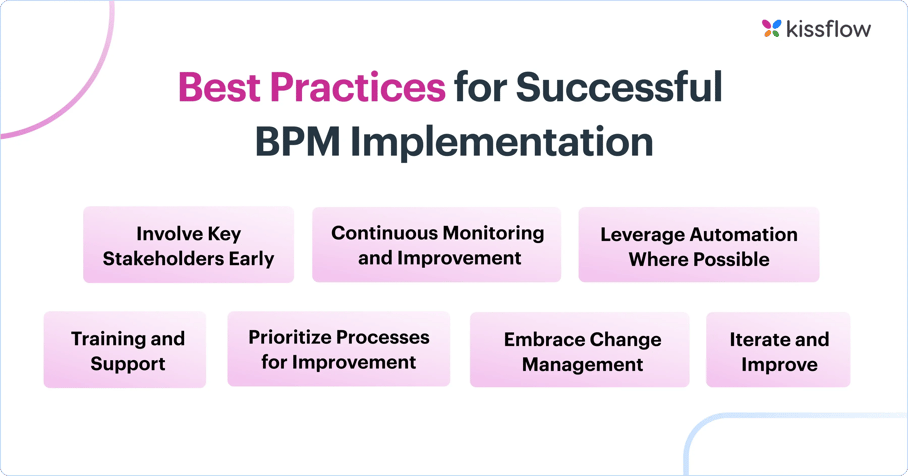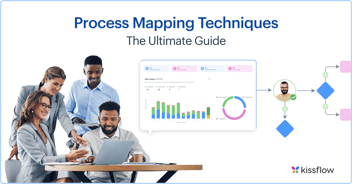
- >
- BPM Software >
- 5 stages in Business Process Management (BPM) Lifecycle
5 stages in Business Process Management (BPM) Lifecycle
Many organizations can improve their processes but need more internal expertise to optimize them. Business Process Management (BPM) tools provide essential support, yet even the most intuitive solutions need a strong foundation of knowledge to unlock their full potential.
Building a solid BPM practice enables organizations to achieve process efficiency. Understanding the BPM phases and the stages of the BPM lifecycle, such as design, execution, monitoring, and optimization, equips teams to make informed decisions. With a clear grasp of each phase, businesses can enhance workflows, drive continuous improvement, and achieve long-term operational success.
What is the Business Process Management Lifecycle?
The BPM lifecycle is the step-by-step process for creating, managing, and improving business workflows. Also referred to as the business process management cycle, this approach helps teams streamline operations and optimize performance across all workflow stages. The stages of business process management are each critical in ensuring processes align with business goals while running efficiently. Following the BPM lifecycle, organizations reduce errors, improve collaboration, and foster continuous improvement.
Learn more: Process automation solutions
The Five Stages of Business Process Management (BPM) Lifecycle
The BPM lifecycle provides a structured framework for designing, managing, and improving business processes. Each stages of business process management lifecycle ensures workflows stay efficient, align with business goals, and adapt to changing needs. Let’s explore the five stages in detail.

1. Design
The design stage lays the groundwork for BPM by identifying current processes and planning improvements that align with business goals. As one of the key BPM phases, this stage evaluates workflows, understands gaps, and decides which processes need changes or additions.
Ask these questions during the design phase:
- What goals do we need our processes to achieve?
- Which workflows need improvement to meet these goals?
- What pain points or inefficiencies exist in the current processes?
- What is the current state of each process?
- Who should take part in designing these workflows?
- Should we introduce new processes to reach our objectives?
Involving business analysts, process owners, and subject matter experts ensures the redesign reflects the needs of all stakeholders. For example, the finance team might focus on faster approvals, while customer service might look to streamline issue resolution. Creating a business case with projected benefits and costs helps secure leadership buy-in early.
2. Model
The modeling stage builds on the design phase by mapping and testing workflows under different scenarios. This visual representation helps teams understand how processes work and where they can introduce efficiencies.
Follow these steps during the modeling phase:
- Identify the inputs and outputs for each step in the process.
- Create flowcharts or process maps to visualize how tasks flow sequentially.
- Simulate scenarios, such as canceled orders or refund requests, to identify potential disruptions.
- Explore automation opportunities for tasks that are repetitive or rules-based.
- Customize workflows to fit each department’s needs, such as automating ticket routing in IT or approvals in HR.
Modeling allows teams to detect bottlenecks early and adjust before moving to the next phase.
3. Execute
Execution brings the planned workflows to life. As one of the crucial BPM phases, this stage involves assigning tasks, deploying processes, and monitoring initial performance to ensure smooth operations.
During execution, take these steps:
- Launch the process on a small scale to test for potential issues.
- Assign roles and responsibilities to ensure the right people manage each step.
- Integrate automation tools to handle repetitive tasks and increase speed.
- Use customized dashboards to track tasks and notify stakeholders of deadlines.
- Monitor how well employees adopt the new processes and provide support where needed.
Testing on a smaller scale helps identify and resolve issues before expanding the process organization-wide.
4. Monitor
Monitoring tracks the performance of workflows in real-time, helping businesses detect inefficiencies and gather insights for improvement. This bpm phase ensures processes remain aligned with business objectives.
Steps to follow during the monitoring phase:
- Track KPIs such as cycle time, error rates, throughput, and customer satisfaction.
- Identify bottlenecks that cause delays or reduce process efficiency.
- Collect feedback from employees and stakeholders to understand challenges.
- Use dashboards to visualize relevant metrics for each team or department.
- Set alerts and notifications to ensure quick responses when issues arise.
Monitoring provides valuable data that guides teams toward necessary adjustments and prepares them for the optimization phase. By understanding how each component fits into the business process management cycle, companies can continuously refine their workflows for better results.
5. Optimize
Optimization focuses on improving processes continuously to achieve better outcomes. This bpm phase ensures workflows remain relevant and effective over time, driving efficiency and reducing costs.
Take these steps during optimization:
- Implement changes based on insights gathered during monitoring.
- Automate additional tasks to reduce manual work and improve productivity.
- Eliminate redundant steps that no longer add value to the workflow.
- Customize optimization efforts for specific departments, such as streamlining procurement approvals or automating invoice tracking in finance.
- Iterate improvements regularly to ensure processes evolve with business needs.
By refining processes, businesses ensure their workflows stay efficient and adaptable to future challenges.
"Most businesses have a limited, explicit understanding of end-to-end business processes, and if any understanding exists, it is often tucked away within disparate groups across the organization. It's rare to find an organization that has linked its scattered process competencies together into a comprehensive strategy."
- Michael Melenovsky, Research Director, Gartner Research
The Impact of Organizational Culture on the BPM Stages
Organizational culture plays a pivotal role in shaping the success of Business Process Management (BPM) by influencing every stages of business process management lifecycle. A collaborative culture fosters better design and modeling, encouraging diverse perspectives and cross-functional inputs. During execution, a culture that embraces change ensures smoother transitions and quick adoption of new workflows while empowering employees to take ownership and drive continuous improvement during the optimization phase.
BPM, in turn, can reshape organizational culture by promoting adaptability, collaboration, and innovation. Employees who feel involved and valued engage more deeply, turning BPM into a shared effort rather than a top-down directive. Aligning culture with BPM creates a feedback loop where processes become more efficient, reinforcing a culture focused on continuous improvement and operational excellence.
Best Practices for Successful BPM Implementation
Implementing business process management (BPM) requires a strategic approach to aligning technology and people. Here are some essential practices to ensure a smooth BPM rollout:

-
Involve Key Stakeholders Early: Engaging process owners, IT teams, and decision-makers from the beginning to ensure alignment and smooth execution. Their insights help shape processes that meet real-world needs while gaining early buy-in from those impacted.
-
Leverage Automation Where Possible: Automating repetitive tasks using BPM tools reduces human error and accelerates workflows. Platforms like Lean BPM emphasize rapid process deployment, allowing organizations to respond quickly to changing requirements while streamlining operations.
-
Continuous Monitoring and Improvement: BPM implementation thrives on constant improvement. Monitoring metrics and collecting feedback in real-time enables quick adjustments, fostering agile responses to internal and external shifts.
-
Training and Support: Training employees with the necessary skills boosts adoption rates. BPM tools should also offer user-friendly interfaces, minimizing reliance on IT for day-to-day adjustments.
-
Prioritize Processes for Improvement: Organizations should focus on high-impact processes rather than tackling all workflows simultaneously. This iterative approach prevents overwhelm and delivers quick wins, encouraging further optimization.
-
Embrace Change Management: BPM initiatives often encounter resistance. Effective change management strategies, including communication and leadership support, help address concerns and build momentum.
-
Iterate and Improve: BPM is not a one-and-done initiative. Rapid iteration and incremental improvements ensure processes align with evolving business needs, enhancing long-term success.
Try Kissflow’s easy-to-use, powerful BPM tool.
Streamlining your business processes can feel overwhelming, especially when you need more specialized expertise. Kissflow BPM takes the complexity out of process management with its user-friendly, no-code interface, empowering you to manage workflows without technical skills. Customizable notifications keep your team accountable, ensuring nothing slips through the cracks. Solve your workflow challenges with Kissflow platform and optimize your team's productivity. Mastering the business process management life cycle equips businesses to scale operations, adapt quickly, and achieve long-term process excellence.
Kissflow’s powerful reporting tools provide real-time insights, helping you track performance and make data-driven improvements. With the drag-and-drop form builder, you can instantly adjust workflows or add parallel branches, keeping processes agile. Our flexible pricing model ensures you get the most out of BPM, making advanced process management accessible and effective for your organization.
Frequently Asked Questions
1. What are the phases of BPM lifecycle?
The BPM lifecycle consists of five key phases: Process Discovery (identifying and documenting current processes), Process Analysis (evaluating efficiency and identifying improvement opportunities), Process Design (creating optimized process models), Process Implementation (deploying and executing the redesigned processes), and Process Monitoring (measuring performance and identifying further improvements). This creates a continuous improvement cycle.
2. How does automation impact BPM implementation?
Automation impacts BPM implementation by accelerating process execution, ensuring consistent application of business rules, providing real-time visibility through automated tracking, generating performance data for continuous improvement, enabling exception-based management focusing human attention where it adds most value, and creating opportunities for self-service process interactions that improve stakeholder experiences.
3. What industries benefit most from BPM?
Industries benefiting most from BPM include financial services (loan processing, claims management), healthcare (patient journeys, insurance authorizations), manufacturing (production workflows, quality management), government agencies (permit processing, citizen services), and logistics companies (supply chain management). Any organization with complex, cross-functional processes gains significant value.
4. What are the latest trends in BPM lifecycle management?
Latest trends in BPM lifecycle management include AI-powered process mining automatically discovering inefficiencies, low-code implementation accelerating deployment, cloud-based platforms enabling collaboration across locations, real-time analytics providing continuous visibility, integrated RPA handling routine tasks, and agile BPM methodologies supporting rapid iteration rather than big-bang implementations.
5. How do I optimize BPM for business efficiency?
Optimize BPM for business efficiency by aligning processes with strategic objectives, eliminating non-value-adding activities, implementing appropriate automation, breaking down departmental silos, establishing clear process ownership and governance, developing meaningful performance metrics, creating mechanisms for continuous improvement, and fostering a process-oriented culture throughout the organization.
6. What are some real-world examples of BPM in action?
BPM is used to automate processes like loan servicing in banks, return handling in retail, expense approvals in teams, and vendor management in global enterprises. It helps reduce manual effort, improve compliance, and accelerate response times across departments.
Sign up for a FREE trial and enjoy a smarter, faster, easier business process monitoring.
Related Articles











%20(1)%20(1).png?width=1997&height=1800&name=The%20ultimate%20buyers%20guide%20to%20BPM%20(1)%20(1)%20(1).png)
